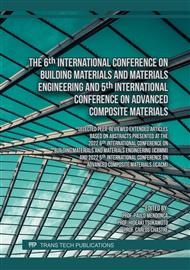[1]
Zhang, B., Rasmussen, B., Jorissen, A., & Harte, A. (2013). Comparison of vibrational comfort assessment criteria for design of timber floors among the European countries. Engineering Structures, 52, 592-607.
DOI: 10.1016/j.engstruct.2013.03.028
Google Scholar
[2]
Mohammed, A. S., Pavic, A., & Racic, V. (2018). Improved model for human induced vibrations of high-frequency floors. Engineering Structures, 168, 950-966.
DOI: 10.1016/j.engstruct.2018.04.093
Google Scholar
[3]
Ljunggren, F., Simmons, C., & Hagberg, K. (2013). Findings from the AkuLite project: Correlation between measured vibro-acoustic parameters and subjective perception in lightweight buildings. In International Congress and Exposition on Noise Control Engineering: 15/09/2013-18/09/2013 (Vol. 2, pp.1578-1585).
Google Scholar
[4]
Armand Decker, S. (2015). Développement d'une méthode d'optimisation multiobjectif pour la construction bois: prise en compte du confort des usagers, de l'impact environnemental et de la sécurité de l'ouvrage (Doctoral dissertation, Bordeaux).
DOI: 10.1051/jtsfen/2013chi05
Google Scholar
[5]
Negreira, J., Trollé, A., Jarnerö, K., Sjökvist, L. G., & Bard, D. (2015). Psycho-vibratory evaluation of timber floors–Towards the determination of design indicators of vibration acceptability and vibration annoyance. Journal of Sound and Vibration, 340, 383-408.
DOI: 10.1016/j.jsv.2014.12.001
Google Scholar
[6]
Hu, L. J., Chui, Y. H., Hamm, P., Toratti, T., & Orskaug, T. (2018). Development of ISO baseline vibration design method for timber floors. In Proceedings of the World Conference on Timber Engineering 2018 (WCTE-2018).
Google Scholar
[7]
Toratti, T., & Talja, A. (2006). Classification of human induced floor vibrations. Building acoustics, 13(3), 211-221.
DOI: 10.1260/135101006778605370
Google Scholar
[8]
Liu, H. (2006). Corrélation entre perception au confort vibratoire et comportement dynamique de planchers bois: apport pour le dimensionnement (Doctoral dissertation, Lyon, INSA).
Google Scholar
[9]
Ussher, E., Arjomandi, K., & Smith, I. 2022. Status of vibration serviceability design methods for lightweight timber floors. Journal of Building Engineering, 50, 104111.
DOI: 10.1016/j.jobe.2022.104111
Google Scholar
[10]
Jarnerö, K., Bard, D., & Simmons, C. (2013). Vibration Performance of Apartment Buildings with Wooden Lightweight Frame-Work–Residents Survey and Field Measurements. AkuLite Report 6.
Google Scholar
[11]
Ebrahimpour, A., & Sack, R. L. (2005). A review of vibration serviceability criteria for floor structures. Computers & Structures, 83(28-30), 2488-2494.
DOI: 10.1016/j.compstruc.2005.03.023
Google Scholar



